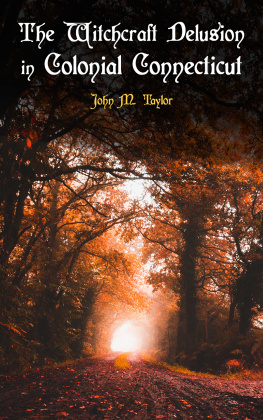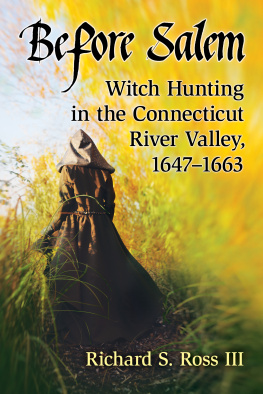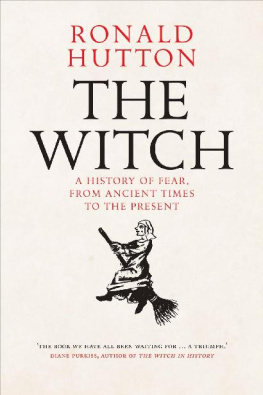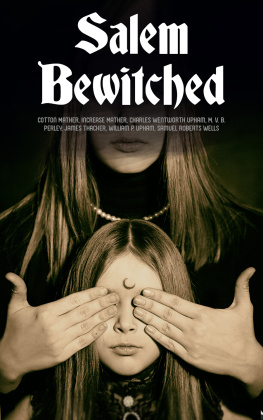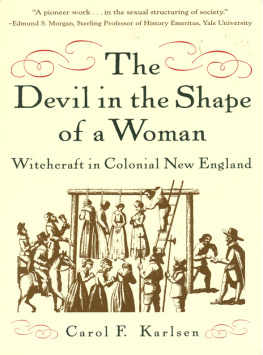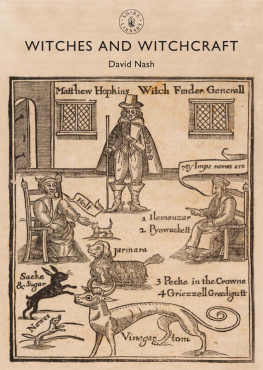Chapter IV
"Hence among all the superstitions that have 'stood over' from primeval ages, the belief in witchcraft has been the most deeply rooted and the most tenacious of life. In all times and places until quite lately, among the most advanced communities, the reality of witchcraft has been accepted without question, and scarcely any human belief is supported by so vast a quantity of recorded testimony."
"Considering the fact that the exodus of Puritans to New England occurred during the reign of Charles I, while the persecutions for witchcraft were increasing toward a maximum in the mother country, it is rather strange that so few cases occurred in the New World." New France and New England (pp. 136-144), FISKE.
The forefathers believed in witchcraftentering into compacts with the Deviland in all its diabolical subtleties. They had cogent reasons for their belief in example and experience. They set it down in their codes as a capital offense. They found, as has been shown abundant authority in the Bible and in the English precedents. They anchored their criminal codes as they did their theology in the wide and deep haven of the Old Testament decrees and prophecies and maledictions, and doubted not that "the Scriptures do hold forth a perfect rule for the direction and government of all men in all duties which they are to perform to God and men."
Massachusetts, Connecticut, and New Haven, early in their history enacted these capital laws:
In Massachusetts (1641):
"Witchcraft which is fellowship by covenant with a familiar spirit to be punished with death."
"Consulters with witches not to be tolerated, but either to be cut off by death or banishment or other suitable punishment." (Abstract New England Laws, 1655.)
In Connecticut (1642):
"If any man or woman be a witchthat is, hath or consulteth with a familiar spiritthey shall be put to death." Exodus xxii, 18; Leviticus xx, 27; Deuteronomy xviii, 10, 11. (Colonial Records of Connecticut, Vol. I, p. 77).
In New Haven (1655):
"If any person be a witch, he or she shall be put to death according to" Exodus xxii, 18; Leviticus xx, 27; Deuteronomy xviii, 10, 11. (New Haven Colonial Records, Vol. II, p. 576, Cod. 1655).
These laws were authoritative until the epidemic had ceased.
Witches were tried, condemned, and executed with no question as to due legal power, in the minds of juries, counsel, and courts, until the hour of reaction came, hastened by doubts and criticisms of the sources and character of evidence, and the magistrates and clergy halted in their prosecutions and denunciations of an alleged crime born of delusion, and nurtured by a theology run rampant.
"They had not been taught to question the wisdom or the humanity of English criminal law." (Blue LawsTrue and False, p. 15, TRUMBULL.)
Here and there in New England, following the great immigration from Old England, from 1630-40, during the Commonwealth, and to the Restoration, several cases of witchcraft occurred, but the mania did not set its seal on the minds of men, and inspire them to run amuck in their frenzy, until the days of the swift onset in Massachusetts and Connecticut in 1692, when the zenith of Satan's reign was reached in the Puritan colonies.
A few words about the tragedy at Salem are relevant and essential. They are written because it was the last outbreak of epidemic demonopathy among the civilized peoples; it has been exploited by writers abroad, who have left the dreadful record of the treatment of the delusion in their own countries in the background; it was accompanied in some degree by like manifestations and methods of suppression in sister colonies; it was fanned into flames by men in high station who reveled in its merciless extirpation as a religious duty, and eased their consciences afterwards by contrition, confession and remorse, for their valiant service in the army of the theological devil; and especially for the contrasts it presents to the more cautious and saner methods of procedure that obtained in the governments of Connecticut and New Haven at the apogee of the delusion.
What say the historians and scholars, some of whose ancestors witnessed or participated in the tragedies, and whose acquaintance with the facts defies all challenge?
"It is on the whole the most gruesome episode in American history, and it sheds back a lurid light upon the long tale of witchcraft in the past." (Fiske's New France and New England, 195.)
"The sainted minister in the church; the woman of the scarlet letter in the market place! What imagination would have been irreverent enough to surmise that the same scorching stigma was on them both." (Scarlet Letter, HAWTHORNE.)
"We are made partners in parish and village feuds. We share in the chimney corner gossip, and learn for the first time how many mean and merely human motives, whether consciously or unconsciously, gave impulse and intensity to the passions of the actors in that memorable tragedy which dealt the death blow in this country to the belief in Satanic compacts." (Among my BooksWitchcraft, p. 142, LOWELL.)
"The tragedy was at an end. It lasted about six months, from the first accusations in March until the last executions in September.... It was an epidemic of mad superstitious fear, bitterly to be regretted, and a stain upon the high civilization of the Bay Colony." (Historic Towns of New England, Salem, p. 148, LATIMER.)
What was done at Salem, when the tempest of unreason broke loose? Who were the chief actors in it? This was done. From the first accusation in March, 1692, to the last execution in September, 1692, nineteen persons were hanged and one man was pressed to death (no witch was ever burned in New England), hundreds of innocent men and women were imprisoned, or fled into exile or hiding places, their homes were broken up, their estates were ruined, and their families and friends were left in sorrow, anxiety, and desolation; and all this terrorism was wrought at the instance of the chief men in the communities, the magistrates, and the ministers.
Upham in his Salem Witchcraft (Vol. II. pp. 249-250) thus pictures the situation.
"The prisons in Salem, Ipswich, Boston, and Cambridge, were crowded. All the securities of society were dissolved. Every man's life was at the mercy of every man. Fear sat on every countenance, terror and distress were in all hearts, silence pervaded the streets; all who could, quit the country; business was at a stand; a conviction sunk into the minds of men, that a dark and infernal confederacy had got foot-hold in the land, threatening to overthrow and extirpate religion and morality, and establish the kingdom of the Prince of darkness in a country which had been dedicated, by the prayers and tears and sufferings of its pious fathers, to the Church of Christ and the service and worship of the true God. The feeling, dismal and horrible indeed, became general, that the providence of God was removed from them; that Satan was let loose, and he and his confederates had free and unrestrained power to go to and fro, torturing and destroying whomever he willed."
The trials were held by a Special Court, consisting of William Stoughton, Peter Sergeant, Nath. Saltonstall, Wait Winthrop, Bartho' Gedney, John Richards, Saml. Sewall, John Hathorne, Tho. Newton, and Jonathan Corwin,not one of them a lawyer.
Whatever his associates may have thought of their ways of doing God's service, after the tragedy was over, Sewall, one of the most zealous of the justices, made a public confession of his errors before the congregation of the Old South Church, January 14, 1697. Were the agonizing groans of poor old Giles Corey, pressed to death under planks weighted with stones, or the prayers of the saintly Burroughs ringing in his ears?

